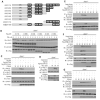Inhibition of NF-kappaB signaling by A20 through disruption of ubiquitin enzyme complexes
- PMID: 20185725
- PMCID: PMC3025292
- DOI: 10.1126/science.1182364
Inhibition of NF-kappaB signaling by A20 through disruption of ubiquitin enzyme complexes
Abstract
A20 negatively regulates inflammation by inhibiting the nuclear factor kappaB (NF-kappaB) transcription factor in the tumor necrosis factor-receptor (TNFR) and Toll-like receptor (TLR) pathways. A20 contains deubiquitinase and E3 ligase domains and thus has been proposed to function as a ubiquitin-editing enzyme downstream of TNFR1 by inactivating ubiquitinated RIP1. However, it remains unclear how A20 terminates NF-kappaB signaling downstream of TLRs. We have shown that A20 inhibited the E3 ligase activities of TRAF6, TRAF2, and cIAP1 by antagonizing interactions with the E2 ubiquitin conjugating enzymes Ubc13 and UbcH5c. A20, together with the regulatory molecule TAX1BP1, interacted with Ubc13 and UbcH5c and triggered their ubiquitination and proteasome-dependent degradation. These findings suggest mechanism of A20 action in the inhibition of inflammatory signaling pathways.
Figures




Comment in
-
Cell biology. Turning off inflammation signaling.Science. 2010 Feb 26;327(5969):1093-4. doi: 10.1126/science.1187271. Science. 2010. PMID: 20185718 No abstract available.
Similar articles
-
Cell biology. Turning off inflammation signaling.Science. 2010 Feb 26;327(5969):1093-4. doi: 10.1126/science.1187271. Science. 2010. PMID: 20185718 No abstract available.
-
The seventh zinc finger motif of A20 is required for the suppression of TNF-α-induced apoptosis.FEBS Lett. 2015 May 22;589(12):1369-75. doi: 10.1016/j.febslet.2015.04.022. Epub 2015 Apr 22. FEBS Lett. 2015. PMID: 25911380
-
The zinc finger protein A20 inhibits TNF-induced NF-kappaB-dependent gene expression by interfering with an RIP- or TRAF2-mediated transactivation signal and directly binds to a novel NF-kappaB-inhibiting protein ABIN.J Cell Biol. 1999 Jun 28;145(7):1471-82. doi: 10.1083/jcb.145.7.1471. J Cell Biol. 1999. PMID: 10385526 Free PMC article.
-
A20 inhibits NF-kappaB activation by dual ubiquitin-editing functions.Trends Biochem Sci. 2005 Jan;30(1):1-4. doi: 10.1016/j.tibs.2004.11.001. Trends Biochem Sci. 2005. PMID: 15653317 Review.
-
Expression, biological activities and mechanisms of action of A20 (TNFAIP3).Biochem Pharmacol. 2010 Dec 15;80(12):2009-20. doi: 10.1016/j.bcp.2010.06.044. Epub 2010 Jul 3. Biochem Pharmacol. 2010. PMID: 20599425 Review.
Cited by
-
Influence of Genetic Polymorphisms on Response to Biologics in Moderate-to-Severe Psoriasis.J Pers Med. 2021 Apr 12;11(4):293. doi: 10.3390/jpm11040293. J Pers Med. 2021. PMID: 33921427 Free PMC article. Review.
-
Deubiquitinating Enzyme: A Potential Secondary Checkpoint of Cancer Immunity.Front Oncol. 2020 Aug 7;10:1289. doi: 10.3389/fonc.2020.01289. eCollection 2020. Front Oncol. 2020. PMID: 32850399 Free PMC article. Review.
-
OTUB1 overexpression in mesangial cells is a novel regulator in the pathogenesis of glomerulonephritis through the decrease of DCN level.PLoS One. 2012;7(1):e29654. doi: 10.1371/journal.pone.0029654. Epub 2012 Jan 18. PLoS One. 2012. PMID: 22279542 Free PMC article.
-
The Inhibition of miR-873 Provides Therapeutic Benefit in a Lipopolysaccharide-Induced Neuroinflammatory Model of Parkinson's Disease.Oxid Med Cell Longev. 2020 Jul 15;2020:8735249. doi: 10.1155/2020/8735249. eCollection 2020. Oxid Med Cell Longev. 2020. PMID: 32724496 Free PMC article.
-
Recognition of pathogen-associated nucleic acids by endosomal nucleic acid-sensing toll-like receptors.Acta Biochim Biophys Sin (Shanghai). 2013 Apr;45(4):241-58. doi: 10.1093/abbs/gms122. Epub 2013 Jan 30. Acta Biochim Biophys Sin (Shanghai). 2013. PMID: 23369718 Free PMC article. Review.
References
Publication types
MeSH terms
Substances
Grants and funding
LinkOut - more resources
Full Text Sources
Other Literature Sources
Molecular Biology Databases
Miscellaneous

